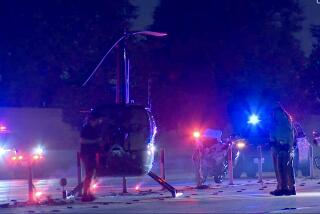A Real High-Wire Act : Project: As their helicopter hovers over 130-foot DWP towers, workers install fiber-optic cable atop transmission lines.
Some people will go to electrifying heights to make a living.
That, anyway, is the way it appeared Tuesday as a crackerjack helicopter crew went about its business of installing a pencil-thick fiber-optic cable atop the Department of Water and Power’s high voltage transmission lines in the eastern San Fernando Valley.
Hovering slightly above the 130-foot-tall towers, the pilot worked to steady the small chopper as a helmeted co-worker, strapped to a platform, attached the cable to a ground wire--a cable carrying no current.
The helicopter swayed; the platform swayed along with it.
From the ground, it all looked, well, death-defying.
Stunned onlookers, seeing the helicopter amidst the high voltage lines, have several times this week reported it to authorities as crashed.
Others simply stare in awe at the free air show.
“The secret to a successful job like this is the skill of the pilot and the crewman,” said Jim Simon, spokesman for Focas Inc. of Alpharetta, Ga., which is installing the cable under a contract with DWP.
“These fellas are what we consider the best in the world. They are highly professional and very skilled.”
Gary Swyter, who is overseeing the project for DWP, said work on the unusual installation project began late last week and is expected to be finished in two or three weeks.
The burgundy-colored cable, which houses 24 fibers, each about as thick as a human hair, will allow DWP to send voice, video and computer data transmissions 35 miles from the utility’s Sylmar switching station to downtown Los Angeles.
The job is expected to cost about $2 million.
Swyter said the operation calls for the helicopter pilot to hover slightly above a tower while the worker sitting on the platform attaches the cable to the wire already in place, piggyback-style.
Once the cable is attached, the helicopter moves on to the next tower, reeling out the cable.
Although it is not necessary to cut the current in the electrical line closest to the helicopter, the DWP has been doing just that for safety’s sake, Swyter said.
There have been no disruptions in customer service, Swyter said.
The helicopter crew will not be used in neighborhoods where transmission towers are situated close to homes because the operation is very noisy, Swyter and others involved concede.
Simon said fiber-optic cable has been installed in other parts of the country by helicopter crews, particularly in heavily populated areas where it would be difficult to dig trenches to bury cable.
The operation is not as dangerous as it might appear from the ground, he said.
In fact, crews elsewhere have worked next to live wires.
“It’s deceiving from the ground,” Simon said. “There is a very considerable distance between the wires and the towers” and the helicopter, he said. “Certainly, there is some movement of the chopper, but it is not significant in terms of danger.
“It looks dangerous, but it really isn’t.”
It would probably be hard to convince some people of that.
Several who watched the chopper crew Tuesday appeared flabbergasted that anyone would even attempt to fly a helicopter so close to the transmission towers.
“I’m glad it’s them and not me,” said North Hollywood resident Ray Thompson, who watched from Elmer Avenue. “I wouldn’t want to be up there.”
“I came over and saw that guy hanging on the outside and it was unbelievable.”
More to Read
Inside the business of entertainment
The Wide Shot brings you news, analysis and insights on everything from streaming wars to production — and what it all means for the future.
You may occasionally receive promotional content from the Los Angeles Times.










